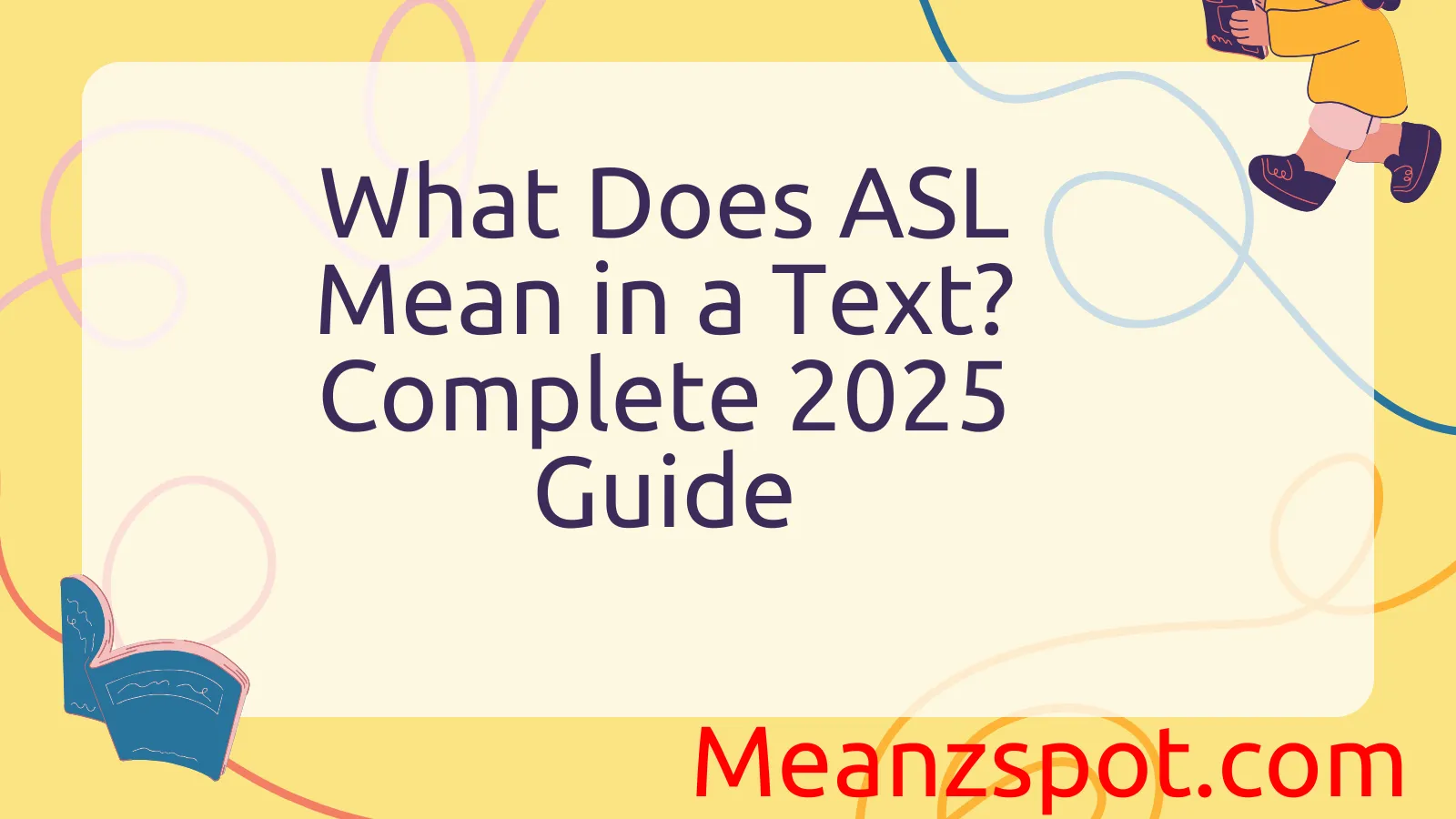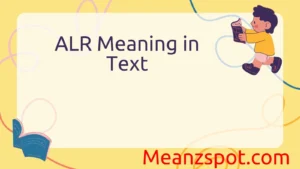If you’ve ever scrolled through texts, TikTok comments, or Snapchat streaks and suddenly saw ASL, you might’ve paused and thought, what does that even mean? Don’t worry — you’re not alone! In 2025, ASL in text has become a popular slang abbreviation, and its meaning depends on context. Sometimes it refers to American Sign Language, while in online chat, it often stands for “age, sex, location” — a throwback to early internet chat rooms that’s still alive today.
With slang evolving faster than ever, understanding ASL meaning in text helps you stay on top of digital conversations, avoid misunderstandings, and even use it to sound more current. Whether you’ve seen it in a Snapchat DM, on TikTok comments, or while texting friends, this guide breaks down all the possible meanings, examples, and how to use ASL naturally in 2025.
Definitions & Meaning
“ASL” can have multiple meanings, depending on context. The most common definitions include:
- American Sign Language – A complete, natural language that serves as the predominant sign language of Deaf communities in the United States and parts of Canada.
- Age, Sex, Location – A shorthand used in online chat rooms to ask someone’s basic information in one quick phrase: “ASL?”
- As Hell (slang) – A more recent, informal usage where “asl” is used to intensify an adjective, e.g., “I’m tired asl” meaning “I’m extremely tired.”
Each of these definitions functions differently. For instance, in educational or accessibility discussions, “ASL” almost always refers to American Sign Language. In contrast, in older internet culture or retro chat applications, it meant “age, sex, location.” And in more modern, casual texting among youth, it may be used as slang to amplify emotions or conditions.
Recognizing which meaning is intended depends heavily on the platform, the person you’re communicating with, and the tone of the conversation.
Origins & History
The acronym “ASL” has deep roots in various contexts:
American Sign Language dates back to the early 19th century. It evolved from a combination of French Sign Language and regional sign languages in the United States, particularly with the establishment of the American School for the Deaf in 1817. ASL as a language has its own grammar and syntax, entirely distinct from English.
The “age, sex, location” version of ASL came into prominence during the rise of internet chatrooms in the late 1990s and early 2000s. Platforms like AOL, Yahoo! Messenger, and IRC made it common for people to open conversations with “ASL?” as a quick way to get to know strangers.
The slang use of “asl” as “as hell” is more modern. It gained popularity in text messages, tweets, and meme culture—especially on platforms like Twitter and TikTok. Here, it’s typically uncapitalized and used for emphasis in casual, humorous, or expressive statements.
Each of these usages arose independently, making “ASL” a fascinating case of linguistic evolution in the digital age.
Usage in Different Contexts
Social Media
On platforms like TikTok, Twitter, or Instagram, “asl” as slang has gained traction. For example, someone might tweet, “That movie was boring asl,” meaning it was very boring. It reflects a casual tone and is often used by younger demographics familiar with current slang trends.
Professional Settings
In a professional or educational setting, ASL almost always refers to American Sign Language. You might see job descriptions asking for ASL fluency, or schools offering ASL as a language course. In disability advocacy, ASL is essential for inclusivity and communication with Deaf communities.
Online Chats
In older online forums and chatrooms, “ASL?” was a quick way to get to know someone, typically in a one-on-one conversation. Although its usage has declined with the rise of more advanced social platforms and dating apps, it still appears in nostalgic references or among users of retro chat systems.
Pop Culture
ASL, especially in reference to American Sign Language, appears in TV shows, music videos, and even on-stage performances where interpreters translate songs or dialogues into ASL. At the same time, the slang version of “asl” is often found in memes, reaction GIFs, and short-form videos.
This diversity of use highlights the adaptability of acronyms in digital culture—and underscores why context is everything.
Common Misunderstandings & Clarifications
Given its multiple meanings, “ASL” is frequently misunderstood. Here are a few common mix-ups:
- Mixing up ASL and ESL: Some confuse American Sign Language (ASL) with English as a Second Language (ESL), though they refer to entirely different concepts.
- Misreading the slang “asl” as a typo: Those unfamiliar with the slang use may assume it’s a misspelling or accidental input.
- Confusing ASL (age, sex, location) with personal questions: In today’s climate, asking for ASL might come across as intrusive or inappropriate, especially if done without context.
- Using ASL slang in formal contexts: Saying “I’m hungry asl” in a work email would be unprofessional and likely misunderstood.
- Assuming one definition fits all: The most important clarification is that “ASL” doesn’t mean the same thing to everyone, everywhere.
Being mindful of the setting and audience when using or interpreting “ASL” ensures smoother, more respectful communication.
Alternatives & Synonyms
Each definition of “ASL” has its own set of alternatives or synonymous expressions:
- For American Sign Language:
- Sign language
- Deaf communication
- Manual language
- For Age, Sex, Location:
- “How old are you?”
- “What’s your gender and where are you from?”
- These days, people tend to ask these questions more directly and sensitively.
- For Asl (as hell):
- “Very” (e.g., “very tired”)
- “Extremely” (e.g., “extremely funny”)
- “So” (e.g., “so cold”)
Using clearer or more specific alternatives is often helpful in formal or cross-generational conversations to avoid confusion.
Frequently Asked Questions (FAQ)
1. What does ASL mean in texting?
In texting, ASL can mean “age, sex, location,” or “as hell” depending on the context.
2. Is ASL still used in chatrooms?
Yes, though less commonly than before. It remains part of early internet culture but may still appear in retro or niche online communities.
3. What does ASL mean on social media?
On social platforms like TikTok or Twitter, “asl” is slang for “as hell,” used for emphasis (e.g., “funny asl”).
4. Is ASL a real language?
Yes. American Sign Language is a complete, natural language with its own grammar and structure, widely used by Deaf communities.
5. Can using ASL in a text be offensive?
It can be, especially if “ASL?” is used without consent or context. Be mindful of how and where you use it.
6. What’s the difference between ASL and BSL?
ASL (American Sign Language) and BSL (British Sign Language) are entirely different languages, with distinct signs and grammar.
7. Why is ASL important?
ASL is essential for accessible communication in the Deaf community and plays a key role in inclusive education and media representation.
Conclusion
The acronym “ASL” offers a compelling snapshot of how language adapts across platforms, generations, and communities. Whether it’s American Sign Language, an internet-era inquiry into someone’s basic info, or a modern-day slang intensifier, “ASL” reflects the layered, ever-evolving nature of human communication. Understanding its multiple meanings empowers us to communicate more effectively and respectfully across different contexts.
In a world increasingly reliant on digital interaction, being literate in these small but impactful abbreviations can make a big difference. Next time you see “ASL” in a message or post, take a moment to consider the context—you just might uncover more than one layer of meaning.



